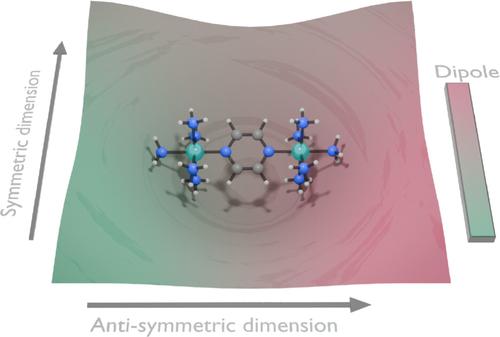当前位置:
X-MOL 学术
›
Angew. Chem. Int. Ed.
›
论文详情
Our official English website, www.x-mol.net, welcomes your feedback! (Note: you will need to create a separate account there.)
Symmetric Electron Transfer Coordinates are Intrinsic to Bridged Systems: An ab Initio Treatment of the Creutz–Taube Ion
Angewandte Chemie International Edition ( IF 16.1 ) Pub Date : 2024-07-01 , DOI: 10.1002/anie.202404727 Adam Šrut 1 , Benjamin J. Lear 2 , Vera Krewald 1
Angewandte Chemie International Edition ( IF 16.1 ) Pub Date : 2024-07-01 , DOI: 10.1002/anie.202404727 Adam Šrut 1 , Benjamin J. Lear 2 , Vera Krewald 1
Affiliation

|
A long‐standing question in electron transfer research concerns the number and identity of collective nuclear motions that drive electron transfer or localisation. It is well established that these nuclear motions are commonly gathered into a so‐called electron transfer coordinate. In this theoretical study, we demonstrate that both anti‐symmetric and symmetric vibrational motions are intrinsic to bridged systems, and that both are required to explain the characteristic shape of their intervalence charge transfer bands. Using the properties of a two‐state Marcus–Hush model, we identify and quantify these two coordinates as linear combinations of normal modes from ab initio calculations. This quantification gives access to the potential coupling, reorganization energy and curvature of the potential energy surfaces involved in electron transfer, independent of any prior assumptions about the system of interest. We showcase these claims with the Creutz–Taube ion, a prototypical Class III mixed valence complex. We find that the symmetric dimension is responsible for the asymmetric band shape, and trace this back to the offset of the ground and excited state potentials in this dimension. The significance of the symmetric dimension originates from geometry dependent coupling, which in turn is a natural consequence of the well‐established superexchange mechanism. The conceptual connection between the symmetric and anti‐symmetric motions and the superexchange mechanism appears as a general result for bridged systems.
中文翻译:

对称电子转移坐标是桥接系统固有的:Creutz-Taube 离子的从头开始处理
电子转移研究中一个长期存在的问题涉及驱动电子转移或定位的集体核运动的数量和特性。众所周知,这些核运动通常被聚集到所谓的电子转移坐标中。在这项理论研究中,我们证明反对称和对称振动运动都是桥接系统固有的,并且两者都需要解释其间隔电荷转移带的特征形状。利用双状态 Marcus-Hush 模型的属性,我们从头计算将这两个坐标识别并量化为正常模式的线性组合。这种量化可以获取电子转移中涉及的势能耦合、重组能和势能表面的曲率,独立于有关感兴趣系统的任何先前假设。我们用 Creutz-Taube 离子(一种典型的 III 类混合价络合物)来展示这些主张。我们发现对称维度是造成不对称能带形状的原因,并将其追溯到该维度中基态和激发态电势的偏移。对称维度的重要性源于几何相关的耦合,而这又是完善的超级交换机制的自然结果。对称和反对称运动与超交换机制之间的概念联系似乎是桥接系统的一般结果。
更新日期:2024-07-01
中文翻译:

对称电子转移坐标是桥接系统固有的:Creutz-Taube 离子的从头开始处理
电子转移研究中一个长期存在的问题涉及驱动电子转移或定位的集体核运动的数量和特性。众所周知,这些核运动通常被聚集到所谓的电子转移坐标中。在这项理论研究中,我们证明反对称和对称振动运动都是桥接系统固有的,并且两者都需要解释其间隔电荷转移带的特征形状。利用双状态 Marcus-Hush 模型的属性,我们从头计算将这两个坐标识别并量化为正常模式的线性组合。这种量化可以获取电子转移中涉及的势能耦合、重组能和势能表面的曲率,独立于有关感兴趣系统的任何先前假设。我们用 Creutz-Taube 离子(一种典型的 III 类混合价络合物)来展示这些主张。我们发现对称维度是造成不对称能带形状的原因,并将其追溯到该维度中基态和激发态电势的偏移。对称维度的重要性源于几何相关的耦合,而这又是完善的超级交换机制的自然结果。对称和反对称运动与超交换机制之间的概念联系似乎是桥接系统的一般结果。











































 京公网安备 11010802027423号
京公网安备 11010802027423号